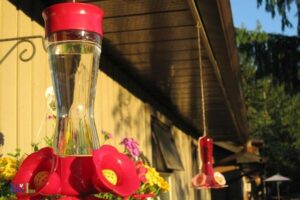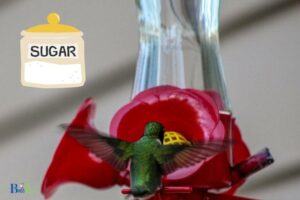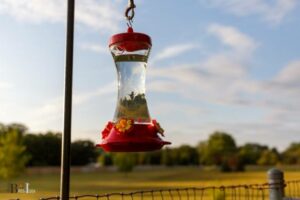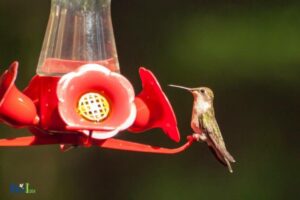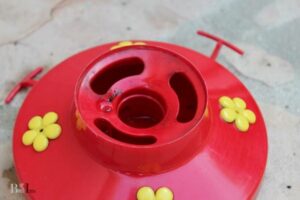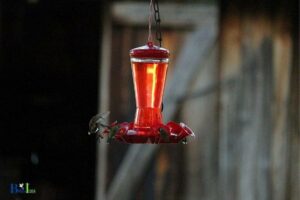When to Put Out Hummingbird Feeders in Nc: Mid-April
The best time to put out hummingbird feeders in North Carolina is early to mid-April.
Hummingbirds usually start arriving in North Carolina during their spring migration, which typically occurs between early April and early May.
By putting out feeders in early to mid-April, you can ensure that you’re prepared for their arrival and provide them with a much-needed food source as they continue their journey north.
Early to mid-April is the ideal time to set up hummingbird feeders in North Carolina, as these tiny birds are in the midst of their annual migration.
Providing a reliable source of food for them during this period not only helps support their energy needs but also increases the likelihood that they will return to your feeder in future years.
To keep your feeder fresh and appealing, ensure that you clean it regularly and refill it with a mixture of sugar and water (a ratio of 4:1, respectively) to mimic natural nectar.
12 Month Timeline to Put Out Hummingbird Feeders in Nc:
| Month | Recommendation for Putting Out Hummingbird Feeders in NC |
| January | Not Recommended |
| February | Not Recommended |
| March | Recommended (late March) |
| April | Highly Recommended |
| May | Highly Recommended |
| June | Highly Recommended |
| July | Highly Recommended |
| August | Highly Recommended |
| September | Recommended (early September) |
| October | Not Recommended |
| November | Not Recommended |
| December | Not Recommended |
Key Takeaway
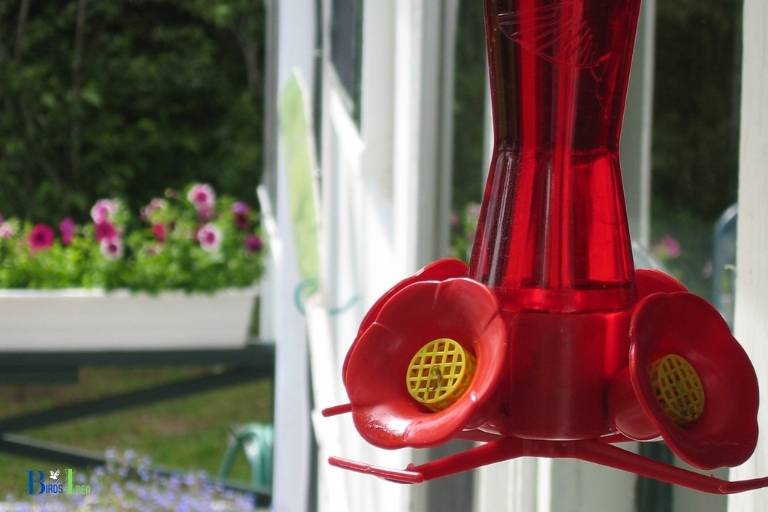
Five Facts About: Hummingbird Feeders in Nc
Bird Migration And Feeding Habits
Discussion Of Hummingbird Feeding Habits And Patterns
Hummingbirds are tiny and energetic creatures that require a constant supply of energy-rich foods. They have a high metabolism rate and need to eat frequently to survive.
Therefore, it is critical to provide them with a steady supply of nectar throughout the year.
Here are some feeding habits and patterns of hummingbirds that you need to be aware of:
- Hummingbirds feed on nectar, insects, and spiders to meet their energy requirements.
- They prefer flowers with tubular shapes that can accommodate their long beaks.
- Hummingbirds prefer fresh nectar, so it is vital to change the nectar in the feeder every 2-3 days.
- They feed during the daytime, taking short breaks to rest.
- Hummingbirds are territorial and will patrol a specific area of a feeder.
Explanation Of How Migration Patterns Impact When To Put Out Feeders
Migration patterns play a crucial role in determining when to put out hummingbird feeders. Hummingbirds in north carolina usually migrate to their breeding grounds in early spring and return to their wintering grounds in late fall.
Therefore, it is essential to be mindful of the timing of their migration patterns when putting out feeders.
Here are some key points about migration patterns:
- Hummingbirds migrate to breed in the spring and return to their wintering grounds in the fall.
- They follow a seasonal pattern, so putting out feeders too early or too late may not attract them.
- In north carolina, hummingbirds generally arrive in early april and stay until september or early october.
- It is best to put out feeders a week or two before their expected arrival to ensure they have enough food when they arrive.
Highlighting The Importance Of Considering Migration Patterns In Nc
Knowing the migration patterns of hummingbirds is crucial for their survival and the success of your feeder. Putting out the feeders at the right time can guarantee that they have a reliable source of food throughout their journey.
Here are some key points to keep in mind when considering hummingbird migration patterns in north carolina:
- North carolina is a part of the eastern migratory path of hummingbirds.
- The state’s climate and geography provide an excellent habitat for these tiny creatures.
- Hummingbirds travel long distances and rely on nectar and insects as sources of energy.
- Feeding hummingbirds during their migration contributes to research and conservation efforts.
Feeding hummingbirds in north carolina requires careful consideration of their feeding habits and migration patterns.
When putting out the feeders, be aware of the timing of their arrival and departure and ensure that they have a constant supply of fresh nectar.
With proper care and attention, hummingbirds will thrive and continue to delight us with their beautiful presence.
Weather And Temperature Considerations
Overview Of How Weather And Temperature Impact Hummingbird Feeding
Hummingbirds are fascinating creatures famous for their agility and vibrant colors. They require a constant fuel source to maintain their high metabolism, and many people like to put up hummingbird feeders to attract them.
However, the time of year and temperature are essential considerations when putting out hummingbird feeders.
Discussion On Best Practices For Temperature And Weather When Putting Out Feeders
The temperature and weather determine the success rate of feeding hummingbirds. As such, it is essential to adhere to best practices when putting out hummingbird feeders.
Here are some tips:
- Place the feeder in the shade to protect the nectar from direct sunlight, which can cause it to ferment quickly.
- Set up a feeder early in the season to attract migrating birds before the flowers bloom.
- Put out multiple feeders to accommodate more birds.
- Clean and refill the feeder every few days to prevent mold growth and to keep the nectar fresh.
- Purchase a thermometer and only put out feeders when the temperature is consistently above 40°f to avoid freezing.
Importance Of Maintaining Consistent Weather And Temperature For Hummingbird Maintenance
Consistent weather and temperature are vital for hummingbirds’ health and well-being. Hummingbirds rely on nectar as their primary source of energy, and changes in temperature and weather can disrupt their feeding patterns and put pressure on their survival.
As such, you should learn how to maintain consistent weather and temperature for hummingbirds.
Here are some additional tips:
- Maintain a consistent feeding schedule, as hummingbirds try to follow a reliable food source.
- Avoid pesticides and chemicals, as hummingbirds are susceptible to these harmful substances.
- Clean the feeder regularly using hot water and vinegar to prevent bacteria and fungus growth.
- During hot weather, change the nectar in the feeder frequently to prevent fermentation.
By following the tips above, you can attract beautiful hummingbirds to your yard and enjoy watching them feed and thrive.
Remember, keeping them healthy is a shared responsibility, and it is up to all of us to maintain a healthy environment for these amazing creatures.
Seasonal Hummingbird Habits
Explanation Of Hummingbird Behaviors According To Seasons In Nc
Hummingbirds are migratory birds that live in north carolina. They travel between their summer and winter habitats, which affects their feeding habits.
Here is what to expect from them during the different seasons.
Spring
- Hummingbirds begin to return to north carolina in late february and early march, after spending the winter in central and south america.
- They start to feed on nectar from blooming flowers like carolina jessamine, redbud, and azaleas.
- They also start to look for man-made nectar feeders to supplement their diet.
Summer
- Hummingbirds are most active during summer months.
- They tend to feed at a consistent frequency and duration each day.
- They are attracted to brightly colored flowers like cardinal flowers, bee balm, and butterfly bush.
- They continue to visit feeders, so it’s essential to clean and refill them regularly.
- However, as the weather gets warmer, hummingbirds may become less active and may take naps in shaded areas or trees.
Fall
- Hummingbirds become less active in the fall as they prepare to migrate south for the winter.
- They will start to consume more food, doubling their weight to store energy for the migration.
- Natural food sources become scarce, and hummingbirds rely more on man-made feeders.
- As the weather grows colder, it is crucial to ensure that nectar feeders are kept clean and filled.
Highlighting The Distinct Seasons And Their Impact On Hummingbird Feeding
The seasons in north carolina have a significant impact on the feeding behavior of hummingbirds.
Here are some ways that each season influences the hummingbirds’ feeding habits and preferences.
Spring
- As north carolina’s weather warms up, flowers start to bloom, and natural food sources become available. This means that hummingbirds are more likely to feed off of flowers.
- During the spring, hummingbirds will also begin to look for man-made feeders to supplement their diet.
- The best time to put out feeders start from late february to early march, coinciding with their return from their winter migration.
Summer
- During summer, the number of flowering plants decreases, and the weather becomes hotter and drier, making nectar a scarce resource.
- Hummingbirds become reliant on man-made nectar feeders, and the frequency of feeder visits increases.
- Summer is also the time when most hummingbirds mate and build nests to lay eggs and raise their young.
Fall
- By fall, most of the native flowers have stopped blooming, and nectar sources become scarce.
- Hummingbirds begin to fatten up to store energy for their long migration to their winter habitats in central and south america.
- Feeders should be kept clean and filled throughout the fall to provide a reliable food source.
Discussion Of The Best Practices To Apply In Feeding Hummingbirds During Each Season
Hummingbirds have different feeding needs during each season. Here’s what you need to keep in mind to attract them to your yard and make sure they have the food they need.
Spring
- Clean and refill feeders every 3-4 days
- Use a solution of four parts water to one part granulated white sugar.
- Avoid using honey, artificial sweeteners, red dyes, or brown sugar.
- Use feeders that are red or orange in color and feature clear plastic to monitor nectar levels.
Summer
- Clean and refill feeders every 2-3 days to keep the nectar fresh.
- Hummingbirds prefer feeders placed in shaded areas.
- Replace the nectar solution with fresh nectar frequently to prevent contamination .
- Clean feeders with hot, soapy water instead of bleach or chemicals, which can be harmful to birds.
Fall
- Leave feeders up until at least a week after you’ve seen the last hummingbird to ensure any late migrants have a food source.
- Clean and refill feeders every 4-5 days as there will be less activity.
- As the weather cools, it is essential to ensure that feeders do not freeze, and the nectar remains unfrozen.
By using these tips, it is possible to provide hummingbirds with the essential food sources they need during each season in north carolina. However, it is crucial to remember the changing seasons and the impact they have on hummingbird behavior.
Tips For Optimizing Feeding
When it comes to attracting hummingbirds to your backyard in north carolina, there are several factors to consider such as feeder color, sugar quantity, placement, and hygiene.
We will discuss the best tips for optimizing feeding locations and maintaining the cleanliness of your hummingbird feeders to ensure the well-being of these fascinating birds.
Discussion For Optimization Of Feeding Locations
Hummingbirds are attracted to nectar sources that are easily accessible and provide protection from predators.
Here are some tips for optimizing feeding locations:
- Hang feeders in areas that are easily visible and accessible to hummingbirds.
- Place the feeders in areas that are not easily accessible by cats or other predators.
- Hang feeders near bushes or other vegetation for perching and resting.
- Place feeders away from windows or shiny objects to prevent collisions.
Overview Of How Feeder Color, Sugar Quantities, And Feeder Placement Can Impact Hummingbird Feeding
Hummingbirds are attracted to bright colors and naturally occurring nectar sources.
Here are some tips for optimizing feeder color, sugar quantities, and feeder placement:
- Use bright red feeders to attract hummingbirds.
- Mix sugar with water in a ratio of 1: 4 (1-part sugar and 4 parts water).
- Avoid using honey, molasses, or artificial sweeteners.
- Hang feeders in shaded areas to prevent nectar spoilage.
- Change nectar every few days to prevent fermentation, mold, and bacteria.
Highlighting The Importance Of Cleanliness And Hygiene In Feeder Maintenance
Hummingbirds are susceptible to diseases caused by dirty and moldy feeders.
Here are some tips for maintaining the cleanliness and hygiene of your feeders:
- Clean feeders with hot water and vinegar once a week.
- Rinse feeders thoroughly with hot water and dry before filling with nectar.
- Use a bottle brush to clean feeders and remove any mold or mildew.
- Monitor feeders regularly for any signs of contamination or spoilage.
- Avoid using pesticides or herbicides near feeding areas.
Remember, hummingbirds are fragile creatures, and their diet mainly consists of nectar.
By following the tips above, you can ensure that your backyard is a safe and healthy haven for these beautiful birds. Happy bird watching!
FAQ For When To Put Out Hummingbird Feeders In Nc
Can Hummingbird Feeders Be Put Out Year-Round In North Carolina?
What Is The Best Time Of Day To Put Out Hummingbird Feeders?
How Often Should I Change The Nectar In My Hummingbird Feeders?
How Far Apart Should I Place Multiple Hummingbird Feeders?
Conclusion
Ultimately, if you reside in north carolina and are looking to attract hummingbirds, it is best to put out hummingbird feeders in early spring.
As soon as the temperatures begin to rise and the flowers start to bloom, these beautiful birds will start to show up in search of food.
Keep in mind that while it is important to provide a steady source of nectar, it is equally important to maintain cleanliness of the feeder.
Always remember to clean and refill the feeder every few days to prevent fermentation and bacterial growth.
If you want to ensure a steady stream of hummingbirds throughout the season, consider planting native flowers that provide nectar and a variety of perches.
With some planning and dedication, you can create a backyard oasis that will attract these tiny creatures and provide you with hours of entertainment.

